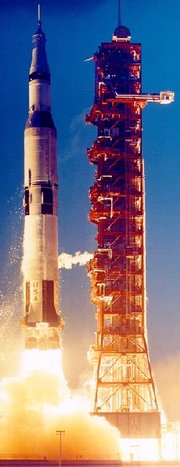Apollo 4
|
|
| Mission Insignia | |
|---|---|
 Apollo insignia | |
| Mission Statistics | |
| Mission Name: | Apollo-Saturn 501 |
| Call Sign: | AS-501 |
| Launch: | November 9, 1967 12:00:01 UTC Kennedy Space Ctr Complex 39A |
| Landing: | November 9, 1967 ~20:37:00 UTC 30° 06' N 172° 32' W |
| Duration: | 8 h 36 min 59 s |
| Number of Orbits: | 3 |
| Apogee: | 116.8 mi (188 km) |
| Perigee: | 113.7 mi (183 km) |
| Period: | 88.3 min |
| Inclination | 32.6 deg |
| Distance Traveled: | ~85,000 mi (~140,000 km) |
| Mass: | 36,782 kg CSM 23,401 kg LTA 13,381 kg |
| AS-501 | |
Apollo 4 was the first unmanned flight of the Saturn V launch vehicle. It was also the first flight of the S-IC and S-II stages of the rocket.
| Contents |
Objectives
Ap4-s67-50531.jpg
This would be the first test of the all-up doctrine. It had been decided in 1963 that instead of testing each component of the rocket separately like had been done by Wernher von Braun in Germany during World War II, the rocket would be tested all at once. This cut down on cost, but meant that everything had to work properly the first time.
There were two main payloads on board. CSM-017 was a production model of the spacecraft that would take the astronauts to the moon. It was a Block I spacecraft meant for testing the systems, and not the Block II spacecraft that would be actually manned. However it did feature some Block II items such as an improved heatshield and a new hatch. The other payload was LTA-10R which was a model of the Lunar Module carried as ballast but with the same mass distribution as the real thing.
The pieces arrive
Saturn_V_IU.jpg
The Command and Service Module (CSM) arrived at the Cape on Christmas Eve 1966. And the second stage arrived 12 January 1967. Only 2 weeks later the fire in the Apollo 1 spacecraft occurred pushing all the schedules back. After an inspection of wiring in the CSM found 1,407 problems the launch was pushed back.
The stacking of the S-II took place on 23 February. This was a precision process; supposedly the crane operators could conceivably "lower the crane hook on top of an egg without breaking the shell". The piece had to be unstacked after hairline cracks were found in another S-II. Inspection found nothing wrong with the Apollo 4 stage. The CSM was finally ready as well and on 20 June it was mated to the rocket and the whole launch vehicle rolled out of the VAB on 26 August - six months after the originally scheduled launch date.
Flight
After a testing regime that lasted two months the rocket was finally ready for launch. The propellant started being loaded on 6 November. In total there was 89 trailer-truck loads of LOX (liquid oxygen), 28 trailer loads of LH2 (liquid hydrogen), and 27 rail cars of RP-1 (refined kerosene).
Although it had been known that the launch would be a sight, what happened was unexpected. The ceiling tiles in CBS newsroom that had been constructed at the Cape for the launch started to fall around Walter Cronkite.
The launch was absolutely perfect and placed the S-IVB and CSM into a 185 kilometres orbit. Then after two orbits of the Earth, the S-IVB reignited for the first time in Earth orbit to put the spacecraft into an elliptical orbit with an apogee of more than 17,000 kilometres. The CSM then fired its own engine to send it out to 18,000 kilometres. Once it had passed the farthest point from Earth, the Service Module engine fired once again to increase the speed of the spacecraft to 40,000 kilometres per hour when it reentered the atmosphere.
It landed 16 km from the target landing site but its descent was visible from the deck of the USS Bennington, the prime recovery vessel.
Capsule location
The Command Module is on display at the NASA's John C. Stennis Space Center, Bay St. Louis, Mississippi.
External links
- Apollo 4 flight listing NASA NSSDC catalog (http://nssdc.gsfc.nasa.gov/database/MasterCatalog?sc=1967-113A)
- Moonport: A History of Apollo Launch Facilities and Operations (http://www.hq.nasa.gov/office/pao/History/SP-4204/cover.html)
- Chariots for Apollo: A History of Manned Lunar Spacecraft (http://www.hq.nasa.gov/office/pao/History/SP-4205/cover.html)
- John C. Stennis Space Center (http://www.ssc.nasa.gov/)

